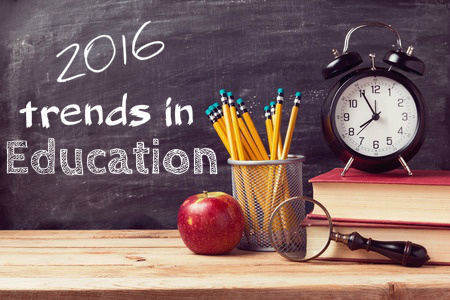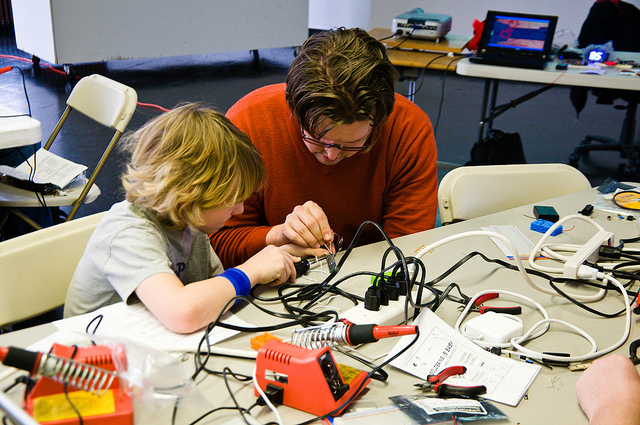
Education has come a long way since just a few decades ago. And today it is changing even more rapidly as advances in neuroscience, social psychology, and technology combine to reshape the educational landscape. As we begin the new year, here are five recent trends in special education, and five more in general education that educators should be aware of in 2016.
1. More focus on dyslexia in Individualized Education Plans
Under the landmark Individuals with Disabilities Education Act (IDEA), schools must design and implement an Individualized Education Program (IEP) for any child determined eligible for special education services. But until recently, processing disorders such as dyslexia, dysgraphia, and dyscalculia have been overlooked, with many school systems and educational agencies reluctant to specifically refer to these disorders within either the evaluation process or the IEPs themselves. In October, the Department of Education issued a guidance which noted that IDEA mentions dyslexia within its list of learning disabilities, encouraged educators to incorporate specific information about such disorders if it helps meet the child’s educational needs, and clarified that this would by no means limit other approaches not related to dyslexia.

2. Dyslexia awareness on the rise
Around the country, lobbying efforts have resulted in increased awareness of dyslexia’s educational impact as well as concrete legislative gains in 20 states. Given what we are learning about its neurological basis, raising awareness of dyslexia among educators and parents is not just a feel-good cause, but improves the chances of early identification and timely interventions that have been proven to significantly impact a child’s educational future.
3. Results-driven accountability gaining traction
In 2014, the Office of Special Education Programs began to shift their oversight of state programs from ensuring that they followed procedural requirements to focusing on the results that those procedures were trying to achieve. By setting clear goals, identifying problem areas, and coordinating with states to create, implement, and revise systemic improvement plans with input from parents and stakeholders, results-driven accountability ensures that the focus of all these programs remains where it belongs – on improving the educational outcomes of children with learning disabilities.
4. Shortage of special education teachers
Although increased legislative attention and oversight with regard to special education programs may provide many benefits to students and families, they have also made it more difficult for school districts to find and retain special education teachers, who face high certification requirements and overwhelming paperwork in addition to an already demanding job. Some districts are hoping to fill the gap through specialized training and fast-track certification programs, but some administrators worry it may not be enough.
5. Multi-tiered System of Support (MTSS)
This system draws on two successful educational approaches: Response to Intervention (RTI), which focuses on learning and academic performance, and Positive Behavior Intervention and Supports (PBIS), which deals with behavioral instruction. Generalizing on the parallel principles behind both methods, MTSS begins with a school-wide core curriculum to bring the highest amount of students to proficiency, moving on to more focused supplemental education for students who respond poorly. Students still struggling are then given individualized intervention to improve their progress. At each stage, a scientific and data-driven approach is used to evaluate student needs and determine optimal strategies for the next tier of instruction.
6. Every Student Succeeds Act
The Every Student Succeeds Act (ESSA) passed in December seeks common ground on some of the controversies that have plagued education reform, while still promoting accountability and national standards for student performance. Instead of threatening to close poorly-performing schools, ESSA aims to help states improve such schools by allowing a broader range of metrics beyond test scores to evaluate student achievement. Furthermore, the act gives states and districts more flexibility in developing situation-specific interventions and directing funding to critical programs and at-risk communities where they are needed most, including specific support for programs such as increasing school hours (Expanded Learning Time) to address student needs and improve school performance.
7. Makerspaces
Recognizing the importance of creativity, design, and technology in the future of education and the global economy, some school districts are partnering with tech companies and nonprofits to provide students with opportunities to work on technology projects such as building computers, engaging their curiosity and promoting simultaneous interdisciplinary learning. Defined as a place where students can gather to create, invent, tinker, explore and discover using a variety of tools and materials, these can be high-tech work areas or they can encompass any area that encourages building and learning to integrate different skills.

Photo credit: MakerSpace Urbana, Feb-2012
by Mitch Altman is licensed under CC BY 2.0
8. Adaptive learning technologies
We have already discussed several new data-driven approaches to student evaluation and development of individualized educational support. Adaptive learning technologies, already used for some time in higher-level standardized testing, help this process by using data to create individualized learning profiles of each student and tailoring their educational experience accordingly. Some educational intervention software programs, such as Fast ForWord, utilize adaptive exercises that help students build reading, language, and cognitive skills that are foundational to learning. Fast ForWord supports struggling students, as well as those working at or above grade level, by improving their ability to learn and retain knowledge.
9. 3D printing
Further harnessing new technologies for education, 3D printers in classrooms will have hands-on applications for students across multiple subjects, from creating art sculptures to modeling geological formations.

Photo credit: ChefJet Candy 3D Printer
by Mauricio Pesce is licensed under CC BY 2.0
10. Digital badges
Using insights from psychology and neuroscience, educators are finally beginning to apply the principles of gamification – already widespread in the corporate and advertising worlds – to learning. Like video game achievements, digital badges engage the brain’s powerful reward mechanism to motivate students and encourage a variety of specific learning outcomes.
While many of these new trends promise to greatly enhance the potential of education to achieve meaningful results, they will also require effort to adapt to. But in a diverse field like education, rapid change is a given and keeping up with the times is not an option, but a necessity.


Comments
Online Learning is trend that
Hi Anna, great point! I'm
I am thankful that the focus
I teach an AP Curriculum in
I have been involved in